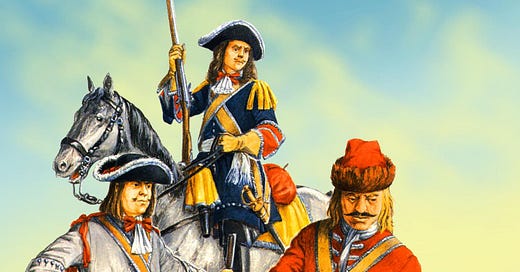Whenever we discuss history, I think it is important to start with overall trends that help us to understand individual persons and events. Once you understand the big trends, then all the other names, dates, and events fall into place. Often times, you can see two competing trends and it is very unclear which will emerge as dominant.
In the Medieval period in Europe (roughly 800-1300), I would say that the main trends were:
The invention of the Medieval farming system in Francia, which roughly doubled food production (enabling all the other trends to take place).
The spread of that farming system to most of Northwest and Central Europe.
The spread of Medieval culture to most of Northwest and Central Europe (largely because of the above).
The establishment of the first Commercial Society in Northern Italy.
The fourth trend was very small geographically, but it was to have a powerful impact on world history.
In the Late Medieval and Early Modern period (roughly 1300-1700), one can see two/three conflicting trends:
The spread of Commercial Societies to Flanders, the Netherlands, and southeast England. This spread was critical to the expansion of human material progress.
The rapid growth of predatory Agrarian empires with centralized royal bureaucracies and armies. Monarchies slowly consumed both smaller feudal domains and autonomous cities.
(related to the above) The expansion of some of those Agrarian empires overseas to the New World and the rim of the Indian Ocean.
I have already written many articles on the first trend. This article will focus on the second trend.
The Empires Strike Back
From 1500 to the modern day, we have seen one empire after another seek to dominate the European continent, but fortunately, they always failed achieve their objective. It was in this period that Europe came to be divided into a half-dozen Great Powers that dominated the continent until 1918, including:
The Spanish Empire, the first great predatory European empire, which dominated European geo-politics from about 1500 until the 1640s.
The Kingdom of France, the dominant power on the Continent from roughly the 1640s until 1870.
The Kingdom of Prussia, which later became the German Empire
The Habsburg Empire, which later became Austria-Hungary
The Russian Empire
The Kingdom of Italy, which unified very late as the peninsula was dominated by the Spanish, French, and Austrian empires
The Ottoman Empire
I am particularly interested in the two opposing trends of the spread of Commercial societies and the spread of predatory Agrarian empires. The outcome of these two opposing trends determined the fate of entire nations. While the Netherlands and the United Kingdom consolidated into Commercial societies, the remainder of the Continent was dominated by increasingly-centralized Agrarian regimes.
The few exceptions were:
Switzerland and most of Scandinavia, which remained independent Free Peasant societies.
Modern-day Germany, which was a jumble of small Agrarian polities until Prussia united it under its rule in 1871.
Modern-day Italy, which was a jumble of small Agrarian polities until the House of Savoy united it under its rule. in 1861.
Poland, which was dominated by feudal nobles until it was carved up by Prussia, Austria, and Russia in the 18th Century. Poland is one of the few examples where an Agrarian regime was able to remain decentralized and avoid becoming controlled by centralized monarchies.
How kingdoms grew
Medieval Europe was a jumble of tiny duchies, counties, and principalities. They were engaged in almost perpetual wars with ever-changing alliances between them. Over time, a few of those tiny polities gained an advantage and grew at the expense of the others. Typically, those polities that grew had initial geographical advantages of:
More fertile soil, which enabled the growth of larger populations and larger armies.
Navigable rivers, which enabled revenue from trade.
Defensible terrain, such as rivers, islands, and peninsulas, provided shelter from sudden attacks. This enabled a greater percentage of resources to be diverted into farming, economic growth, and building up a powerful military.
Crafty rulers leveraged these initial geographical advantages into permanent growth by:
Convincing local nobles that a strong royal army was needed to defend themselves against other kingdoms. Short-term military emergencies were leveraged into taxes that never seemed to go away.
Taxing the peasantry to build a stronger military.
Using this military to:
Suppress domestic opposition from local nobles or peasant revolts.
Conquer more lands to raise more tax revenues.
Integrating the feudal nobility into the monarchy’s bureaucracy and military, so that they were not independent threats to the monarchy.
Compensating the nobility for this loss of independence by:
Maintaining a docile peasantry (so the monarchy could extract taxes and the nobility could extract land rents)
Exempting the nobility from taxation.
Constant improvement of quality of the military under the pressure of repeated wars.
Any ruler that failed to consolidate a similar centralized state risked subjugation by those rulers who did. The only regions that were exempt from this trend were:
Commercial societies that could defend themselves and who got rich through trade.
Geographical regions that lacked fertile soil or critical natural resources but were easy to defend because of geography. Those regions were not worth fighting over. Switzerland and Scandinavia were key examples.
Royal centralization almost killed material progress
I believe that this relentless trend of centralization and larger kingdoms gobbling up smaller polities was a fundamental threat to human material progress. If the Kingdom of France or any other predatory regime had been able to gobble up the Dutch Republic and England, the material progress would likely have been killed before it got going.
Indeed, the French invasion of Northern Italy in 1494 is often seen as the beginning of the end of the flourishing of the region. The Spanish Empire was able to stifle the independence and likely the economic growth of Flanders. The famous Sack of Antwerp in 1576 is often seen as the prime cause of the economic decline of Antwerp. so two of the four main Commercial societies that played such a key role in getting human material progress started were stifled by predatory Agrarian regimes.
Could the other two Commercial societies have suffered the same fate?
What if the French invasion in 1672 had annihilated the Dutch Republic (it almost succeeded)?
What if the famous Spanish Armada in 1588 succeeded in conquering England?
Any military historian who objectively analyzed the balance of military forces in those two conflicts would have made the invaders the favorites. Perhaps the conquering power would have allowed a certain amount of political and economic autonomy, but it seems more likely that the victors would have deliberately stifled economic growth so that the region would not become a threat to its power.
If both the Dutch Republic and England had been crushed, what other Commercial society could have evolved to keep the flame of material progress going? Perhaps North America, or perhaps nowhere. With so much at stake, I do not like the odds.
Northwest Europe might have developed along the same lines as other Eurasian regions with little if any material progress for the masses and constant military struggle between Agrarian empires.
See more of my articles on European history.








I enjoyed this discussion. One thing I admittedly don't understand very well: what did decline look like in an advanced commercial city that was subsumed by a larger empire? Would there be outright noticeable technological/economic regression -- for example, advanced commercial farms come to resemble ordinary agriculture in the conqueror's empire? Or is it more about progress ceasing than an outright regression, as the place is gradually left in the dust by the remaining independent commercial societies?
Also, I might quibble with your point about which agrarian empires succeeded:
>Typically, those polities that grew had initial geographical advantages
This seems to describe France well enough, but who else had noticeable advantages over their neighbors? A first glance suggests that many of Early Modern Europe's empires had their origins in what we would think of as not-especially-fertile lands.
Meanwhile:
>Crafty rulers leveraged these initial geographical advantages into permanent growth by:
The points you list here are good, and I'm inclined to think this is nearly the whole story in central and eastern Europe. I would say the winners at the game of empire-building were mostly decided by a combination of successful administrative/military reforms, fortuitous marriages/inheritances, and adroit diplomacy.
There's perhaps also room for theories of collective solidarity -- asabiyyah, Turchin's ideas, etc. E.g. were the Prussian/Brandenburgian people, or the Prussian noble/military caste, more culturally inclined to invest in the military success of the Prussian state than Rhinelanders were on behalf of their own states? We could pose many theories as to WHY this might be so, the most obvious being a more recent history of proximity to hostile non-German and non-Christian peoples and a population more recently descended from conquerors and colonists.
Now this is very interesting.
Yes, the previous economic competition was between the Agrarian society and the emerging Corporate Capital Industrial Age.
Look at France today and the relative societal power balance centuries into this dynamic... farmer protests in Paris and probably even taking the month of August as vacation.
If Commercialization had been stifled entirely, we'd be in a very different place.